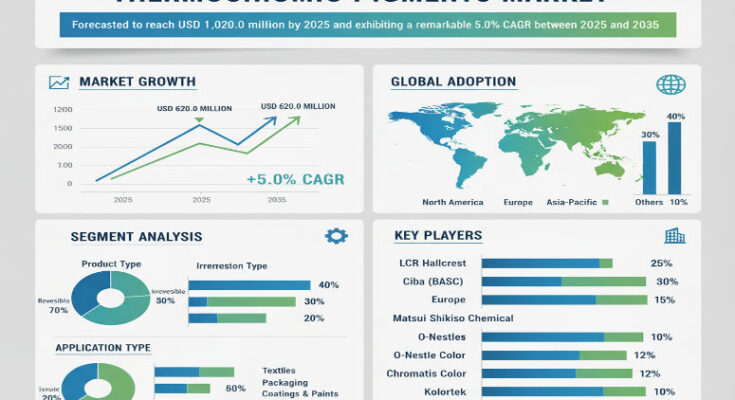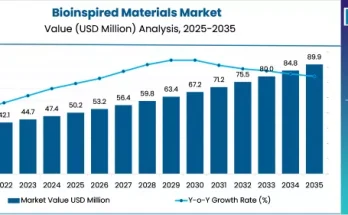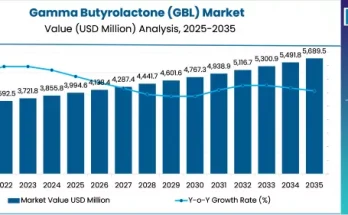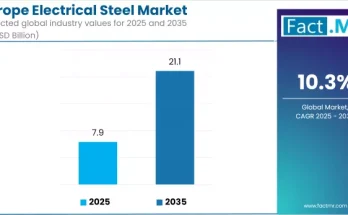The thermochromic pigments market is charting a strong growth trajectory as demand for temperature-responsive color materials expands across industries. Analysts estimate the market was valued at around USD 517.6 million in 2023, with forecasts indicating steady expansion driven by new applications. These specialty pigments, which change color in response to temperature changes, are increasingly used in packaging, textiles, security, coatings, and other innovative sectors.
Market Drivers and Growth Catalysts
Several key factors are underpinning the growth in the thermochromic pigments market. The demand for smart packaging is rising, especially in food, pharmaceuticals, and cold-chain logistics, where pigments provide visual evidence of temperature abuse through irreversible color changes. This helps ensure product integrity, safety and regulatory compliance. Meanwhile, reversible pigments are gaining traction in textiles, fabrics, and consumer goods, where materials change color dynamically based on ambient or body temperature, adding functional or aesthetic value. Advances in microencapsulation and pigment formulation are improving durability, stability, and response speed, making these products more viable for harsh environments or repeated color cycles.
Product Segmentation & Key Applications
Thermochromic pigments are broadly categorized into reversible and irreversible types. Reversible pigments can toggle back and forth between colors as temperature changes, making them ideal for reusable applications such as smart textiles, reusable labels, or dynamic coatings. Irreversible pigments change their color permanently upon exceeding a threshold temperature, making them suitable for one-time indicators in packaging, cold-chain indicators, or irreversible safety seals.
In terms of applications, major segments include inks and printing (for temperature labels or security printing), plastics and polymers (pigmented products that shift color when heated or cooled), textiles (e.g. garments or fabrics that change hue), paints and coatings (architectural or industrial coatings that respond to temperature), and other emerging areas like smart windows or temperature indicators / sensors.
Regional Insights and Growth Opportunities
Geographically, established markets such as North America and Europe are strong adopters of thermochromic pigments, especially in packaging, food / pharmaceutical safety indicators, and high-performance smart textiles. These regions tend to have stringent regulations and higher awareness of performance / safety standards, supporting adoption of both irreversible and reversible pigment solutions.
The Asia-Pacific region is a high-growth area, driven by rapid industrialization, expanding textile manufacturing, large packaging industries, and growing consumer demand for novelty and functional products. Textile producers and packaging converters in countries such as China, India, and Southeast Asia are increasingly incorporating thermochromic pigments into fabrics or packaging to enhance product value, aesthetics or functionality. Other regions (Latin America, Middle East & Africa) also show opportunity potential as infrastructure improves and regulatory awareness increases.
Competitive Landscape & Strategic Trends
Suppliers in the thermochromic pigment space are focusing on innovation in pigment microencapsulation, stability against UV, moisture and repeated thermal cycling, improving color change thresholds, and expanding the operational temperature range. Many players are partnering with packaging companies, textile manufacturers or coating formulators to develop customized pigment formulations that meet specific temperature thresholds or color transitions. As costs decline due to advances in manufacturing and scale, these pigments become more accessible to broader markets.
Challenges and Market Restraints
Despite the promising demand, some constraints exist. The cost of thermochromic pigments remains higher than conventional pigments, which can limit adoption in price-sensitive applications. Additionally, certain formulations may only operate within narrow temperature ranges, limiting their usefulness in extreme cold or high-heat conditions. Durability and light-fastness can also be issues in outdoor or high-UV environments, where repeated thermal cycles may degrade performance.
Forecast & Strategic Recommendations
Looking forward, continued growth is expected as adoption expands across packaging, textiles, coatings, and emerging smart applications. Suppliers should focus on lowering manufacturing costs, broadening temperature window capabilities, improving pigment stability, and customizing thresholds for different use cases. Establishing regional production and partnerships with end-users (packaging / textile / coatings manufacturers) will help accelerate adoption in fast-growing markets. Emphasizing value added by irreversible indicators in cold-chain logistics or reversible effects in consumer products will support premium positioning.
Browse Full Report: https://www.factmr.com/report/thermochromic-pigments-market
Editorial Perspective
Thermochromic pigments are more than just colorants—they are functional materials enabling new interactive, safety, or temperature-responsive applications. As industries seek to differentiate products or improve safety and quality in logistics or textiles, these pigments become key enablers. Suppliers who innovate on temperature range, cost, and durability will lead the next wave of demand as applications expand from novelty use to mission-critical packaging, textiles and coatings.



